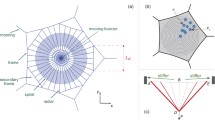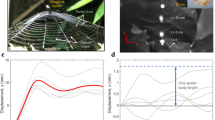Abstract
Spiders are able to extract crucial information, such as the location prey, predators, mates, and even broken threads from propagating web vibrations. The complex structure of the web suggests that the morphology itself might provide computational support in form of a mechanical signal processing system - often referred to as morphological computation. We present preliminary results on identifying these computational aspects in naturally spun webs. A recently presented definition for physical computational systems, consisting of three main elements: (i) a mathematical part, (ii) a computational setup with a theoretical and real part, and (iii) an interpretation, is employed for the first time, to characterize these morphological computation properties. Signal transmission properties of a real spider orb web, as the real part of a morphological computation setup, is investigated in response to step transverse inputs. The parameters of a lumped system model, as the theoretical part of a morphological computation setup, are identified empirically and with the help of an earlier FEM model for the same web. As the possible elements of a computational framework, the web transverse signal filtering, attenuation, delay, memory effect, and deformation modes are briefly discussed based on experimental data and numerical simulations.
Access this chapter
Tax calculation will be finalised at checkout
Purchases are for personal use only
Similar content being viewed by others
References
Vollrath, F., Selden, P.: The role of behavior in the evolution of spiders, silks, and webs. Ann. Rev.Ecol.Evol. Syst. 38(1), 819–846 (2007)
Vollrath, F.: Coevolution of behaviour and material in the spiders web. In: Biomechanics in Animal Behaviour, pp. 315–29 (2000)
Slotta, U., Hess, S., Spie, K., Stromer, T., Serpell, L., Scheibel, T.: Spider silk and amyloid fibrils: a structural comparison. Macromol. Biosci. 7(2), 183–188 (2007)
Guan, J., Vollrath, F., Porter, D.: Two mechanisms for supercontraction in nephila spider dragline silk. Biomacromolecules 12, 4030–4035 (2011)
Masters, W.M., Markl, H.: Vibration signal transmission in spider orb webs. Science 213, 363–365 (1981)
Barth, F.G., Geethabali: Spider vibration receptors: Threshold curves of individual slits in the metatarsal lyriform organ. J. Comp. Physiol. 148, 175–185 (1982)
Mortimer, B., Soler, A., Siviour, C.R., Zaera, R., Vollrath, F.: Tuning the instrument: sonic properties in the spider’s web. J. R. Soc. Interface 13, 20160341 (2016)
Mortimer, B., Soler, A., Siviour, C.R., Vollrath, F.: Remote monitoring of vibrational information in spider webs. Sci. Nature 105, 37 (2018)
Aoyanagi, Y., Okumura, K.: Simple model for the mechanics of spider webs. Phys. Rev. Lett. 104, 038102 (2010)
Soler, A., Zaera, R.: The secondary frame in spider orb webs: the detail that makes the difference. Sci. Rep. 6, 31265 (2016)
Masters, W.M.: Vibrations in the orbwebs of nuctenea sclopetaria (Araneidae): I. Transmission through the web. Behav. Ecol. Sociobiol. 15(3), 207–215 (1984)
Masters, W.M.: Vibrations in the orbwebs of nuctenea sclopetaria (Araneidae): II. Prey and wind signals and the spider’s response threshold. Behav. Ecol. Sociobiol. 15(3), 217–223 (1984)
Krushynska, A.O., Bosia, F., Miniaci, M., Pugno, N.M.: Tunable spider-web inspired hybrid labyrinthine acoustic metamaterials for low-frequency sound control. New J. Phys. 19, 105001 (2017). arXiv:1701.07622
Hauser, H., Füchslin, R.M., Pfeifer, R.: Opinions and Outlooks on Morphological Computation. E-Book (2014)
Nakajima, K., Li, T., Hauser, H., Pfeifer, R.: Exploiting short-term memory in soft body dynamics as a computational resource. J. R. Soc. Interface 11, 20140437 (2014)
Nakajima, K., Hauser, H., Li, T., Pfeifer, R.: Information processing via physical soft body. Sci. Rep. 5, 10487 (2015)
Hauser, H., Ijspeert, A.J., Füchslin, R.M., Pfeifer, R., Maass, W.: The role of feedback in morphological computation with compliant bodies. Biol. Cybern. 106, 595–613 (2012)
Hauser, H., Ijspeert, A.J., Füchslin, R.M., Pfeifer, R., Maass, W.: Towards a theoretical foundation for morphological computation with compliant bodies. Biol. Cybern. 105, 355–370 (2011)
Pfeifer, R., Bongard, J.: How the Body Shapes the Way We Think: A New View of Intelligence. MIT Press, Cambridge (2006). Google-Books-ID: EHPMv9MfgWwC
Sornkarn, N., Howard, M., Nanayakkara, T.: Internal impedance control helps information gain in embodied perception. In: Proceedings - IEEE International Conference on Robotics and Automation, pp. 6685–6690 (2014)
Sadati, S., Sullivan, L., Walker, I., Althoefer, K., Nanayakkara, T.: Three-dimensional-printable thermoactive helical interface with decentralized morphological stiffness control for continuum manipulators. IEEE Robot. Autom. Lett. 3, 2283–2290 (2018)
Zhao, Q., Nakajima, K., Sumioka, H., Hauser, H., Pfeifer, R.: Spine dynamics as a computational resource in spine-driven quadruped locomotion. In: 2013 IEEE/RSJ International Conference on Intelligent Robots and Systems, pp. 1445–1451, November 2013
Ghazi-Zahedi, K., Haeufle, D.F.B., Montfar, G., Schmitt, S., Ay, N.: Evaluating morphological computation in muscle and DC-motor driven models of hopping movements. Front. Robot. AI 3, 42 (2016)
Ghazi-Zahedi, K., Langer, C., Ay, N.: Morphological computation: synergy of body and brain. Entropy 19, 456 (2017)
Füchslin, R.M., Dzyakanchuk, A., Flumini, D., Hauser, H., Hunt, K.J., Luchsinger, R.H., Reller, B., Scheidegger, S., Walker, R.: Morphological computation and morphological control: steps toward a formal theory and applications. Artif. Life 19, 9–34 (2012)
Giunti, M.: Computation, Dynamics, and Cognition. Oxford University Press, New York (1997)
Giunti, M.: What is a physical realization of a computational system? ISONOMIA, 9(Epistemologica Series, Special Issue: Reasoning, Metaphor and Science), 177–192 (2017)
Sadati, S., Naghibi, S., Naraghi, M.: An automatic algorithm to derive linear vector form of lagrangian equation of motion with collision and constraint. Procedia Comput. Sci. 76, 217–222 (2015)
Sadati, S.: AutoTMTDyn Software Package, May 2017. https://github.com/hadisdt/AutoTMTDyn
Acknowledgment
This work is supported by the Leverhulme Trust Research Project, “Computing with spiders’ web”, number RPG-2016-345, granted to H.H. and F.V.; and the Royal Academy of Engineering (research fellowship RF1516/15/11), granted to L.R. With special thanks to Dr. Helmut Hauser, Dr. Ludovic Renson, Dr. Beth Mortimer, Prof. Fritz Vollrth, Dr. S. Elnaz Naghibi and Alan Quille who contribute to this research by helpful discussions, exchanging ideas, proofreading the draft and providing helpful comments.
Author information
Authors and Affiliations
Corresponding author
Editor information
Editors and Affiliations
Rights and permissions
Copyright information
© 2018 Springer International Publishing AG, part of Springer Nature
About this paper
Cite this paper
Sadati, S.M.H., Williams, T. (2018). Toward Computing with Spider Webs: Computational Setup Realization. In: Vouloutsi , V., et al. Biomimetic and Biohybrid Systems. Living Machines 2018. Lecture Notes in Computer Science(), vol 10928. Springer, Cham. https://doi.org/10.1007/978-3-319-95972-6_43
Download citation
DOI: https://doi.org/10.1007/978-3-319-95972-6_43
Published:
Publisher Name: Springer, Cham
Print ISBN: 978-3-319-95971-9
Online ISBN: 978-3-319-95972-6
eBook Packages: Computer ScienceComputer Science (R0)




